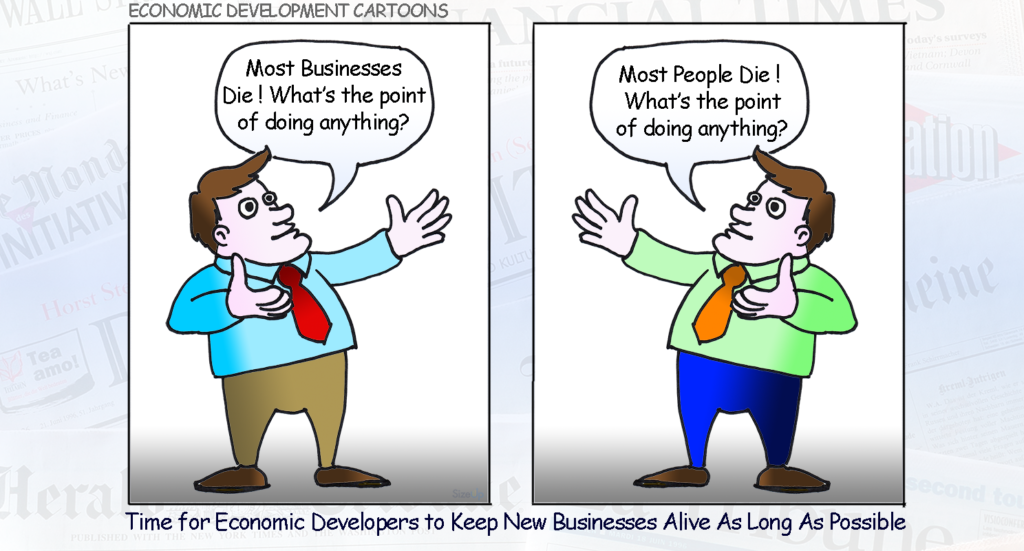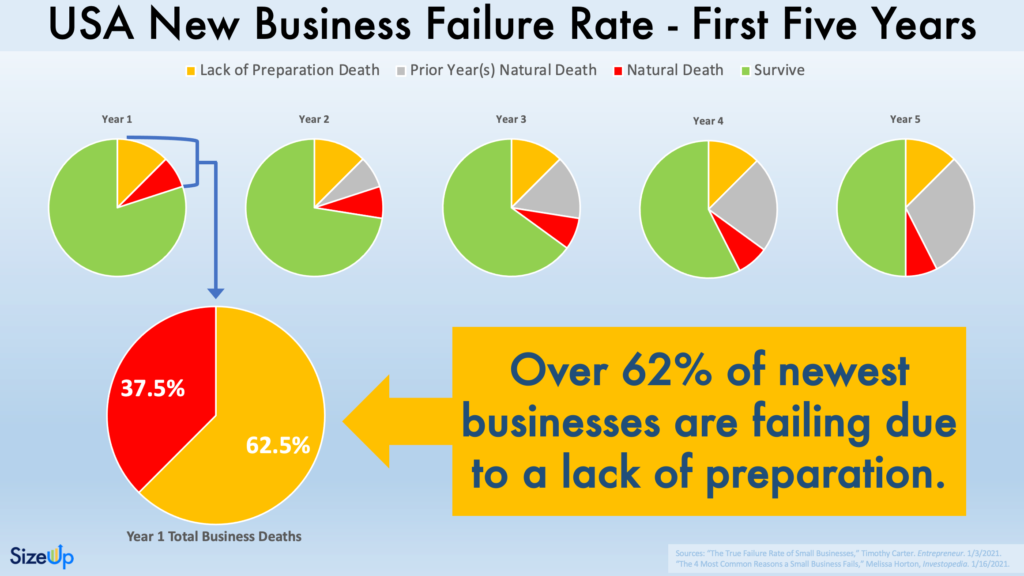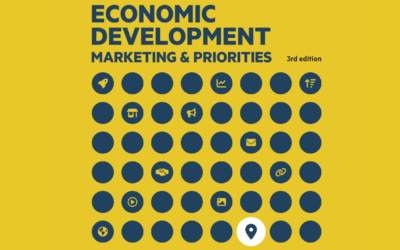
About 20 percent of small businesses fail within their first year, according to data from the Bureau of Labor Statistics. By the end of the second year, 30 percent of businesses will have failed, and by the end of the fifth year, about half of businesses will have failed.[1]
A problem with the overstated numbers for business failure is the definition of what is considered “failure.” If a business no longer exists, it is counted as a failure. But there may be very logical reasons why a business no longer exists. For example, an owner of a business may have decided to retire and simply close the business. Or an entrepreneur may have become rich selling his small business to a large company that absorbed the assets and employees before closing the corporate shell. That newly rich entrepreneur won’t feel like the business closing was a failure; it was a success.
However, undesired business closings do happen. Preventing the failure of these businesses is a major opportunity for communities to improve their economies and the sustainability of businesses. Economic developers can become leaders in reducing preventable failures.
The business failure rate is insightful because it tells you when businesses tend to fail. 20% of businesses fail in the first year, but an additional 30% fail in years 2, 3, 4, and 5. 30% divided by 4 years equals an average of 7.5% of businesses failing each of these years. If 7.5% is a predictable/natural rate of business death, then 12.5% of businesses (1 out of 8 of all businesses) are failing in the first year due to “lack of preparation in one way or another.”[2] Being better prepared than the bottom 1/8th of all businesses positions an entrepreneur for a much higher likelihood of success.

A lack of preparation is a key part of all the four most common reasons that small businesses fail:[3]
- Financing challenges – Running out of money will kill a company and this is more likely to happen if the entrepreneur doesn’t know how much money is needed for their type of business to cover costs of operation, how much businesses like theirs typically make, how many employees are typically needed, and the average salaries for these employees.
- Poor management – A business owner may have strong skills related to creating and selling a product or service but may not know how to manage and oversee company operations. Companies need to know how to manage finances, hiring, and marketing.
- Inadequate business planning – Entrepreneurs who fail to develop a plan before they start their business to understand competitor analysis, marketing initiatives, capital needs, the industry marketplace, and a plan for the business, have built instability and greater risk into their start.
- Marketing mistakes – Marketing is crucial to the success of new businesses and without knowing how to accurately identify, target, and convert prospects into customers a business is more likely to fail compared to companies that implement successful campaigns.
If 1/8th of business failures can be mitigated through preparation, then economic developers can have a significant impact in reducing this failure rate. EDOs can prepare entrepreneurs with the information, training, and infrastructure needed to move out of this bottom 1/8th of businesses that fail quickly. This also has long-term benefits to local economies because each business that survives the first year produces a larger total pool of businesses surviving into every future year. Preventative preparation investment causes generational business sustainability.
Here are three practical ways economic developers can help prepare businesses to reduce small business failure:
ONLINE
Online services provide a convenient way for entrepreneurs to access services whenever they want, wherever they are, and with the increasingly popular method of do-it-yourself assistance. This is also one of the easiest ways for economic developers to implement entrepreneurial assistance as it requires the least (or almost no) staff time and is the lowest cost.
Online Research
In today’s information economy, businesses without access to information are at a much higher risk for failure or stunted growth. Preparation requires information, but entrepreneurs typically don’t have access nor can they afford high quality market research. Many economic development organizations are bridging this gap by providing local entrepreneurs with easily understandable market research based on big data, algorithm-based analysis, super-computing, and which is delivered on the EDO website using SizeUp technology. It is detailed by industry-specificity and is geographically relevant.
Entrepreneurs can use the software for free on their local EDO’s website to estimate the viability of their business and test assumptions of their business plan. In addition, they can use the software to discover potential customers, find local suppliers, and can optimize their marketing by targeting ideal customers.
The need from entrepreneurs to access this information and the demand from EDOs to deliver it to local businesses has resulted in rapid implementation by EDOs across the USA. In 2020 alone, over ¼ of the IEDC Board of Director organizations implemented SizeUp including Sacramento, Colorado Springs, Dallas, Tucson, Tulsa, Detroit, Atlanta, and Pflugerville (a suburban Texas city with a population of 61,737).
Online Training
Business education and training from top university professors can now be accessed by entrepreneurs for free from edX. The global non-profit edX has over 120 university and institutional partners. There are currently over 450 available courses for business and management with subject areas including digital strategy, economics, finance, product development, and operations. Economic development organizations can link to these services from their websites and promote these professional development opportunities to small businesses and entrepreneurs in your community.
There are also for-profit online business training platforms such as Udemy that provide thousands of courses for small business owners, managers, and entrepreneurs. Udemy has promoted itself as helping “organizations of all kinds prepare for the ever-evolving future of work” by providing courses taught by instructors who are “experts who stay active in their fields in order to deliver the most up-to-date content”.[4] Because courses on Udemy must be purchased, EDOs could consider allocating small business training budgets to subsidize the costs for local companies wanting to access this customized job training education.
IN PERSON
Incubators and Coworking
Incubators provide a physical location with shared services to help companies get started and become stable enough to venture into an independent location. They often reduce costs by having shared office resources such as telephone, internet, meeting rooms, and reducing initial capital investments in items such as copiers and office equipment. Some provide small business training to help the co-located tenants, which tend to be in similar situations in the early stage of their business and need to learn the basics of operating a business.
The private sector has also entered the incubator market in the form of coworking spaces. Coworking has appealed to new companies and the growing number of contract workers. There are many types of coworking spaces run by different non-profit, government, and for-profit organizations. These coworking office spaces often provide similar services found in traditional business incubators.
There is growing research about the potential ineffectiveness of incubators and whether they are simply self-serving. Research from the Kauffmann Foundation shows that most incubators typically only have 2 employees but serve 25 businesses, on average. They question the plausibility that so few employees can impact so many companies. Kauffmann’s research also shows that there is little study or evidence that incubated companies out-perform unincubated companies. A dissertation from Alejandro Amezcua shows that incubated businesses have higher job creation and sales growth but lower survival rates after graduating, however, these variations were marginal.
If your organization has an incubator/accelerator or is considering starting one, to be successful the initiative needs to have the adequate resources, staffing, mentors, and measurable metrics to make sure your incubator is adding value to your business ecosystem.
REDUCING 63% OF NEW BUSINESS FAILURES
While it is inevitable that some portion of all businesses will die, economic developers are uniquely positioned to help reduce the failure rate by proactively intervening so that aspiring entrepreneurs are better prepared to sustain their business. It is well understood that 20% of businesses fail in their first year. But if 12.5% of all businesses are dying for the preventable cause of a lack of preparation and access to resources, it logically follows that an astounding 63% of first-year business failures can be mitigated and reduced through the direct engagement of economic developers implementing proactive programs designed to reduce the failure rate.
[1] United States Bureau of Labor Statistics. Table 7. Survival of private sector establishments by opening year.
[2] “The True Failure Rate of Small Businesses,” by Timothy Carter. Entrepreneur. January 3, 2021.
[3] “The 4 Most Common Reasons a Small Business Fails,” by Melissa Horton, Investopedia. January 16, 2021.
[4] Udemy About Us webpage. May 2019.



